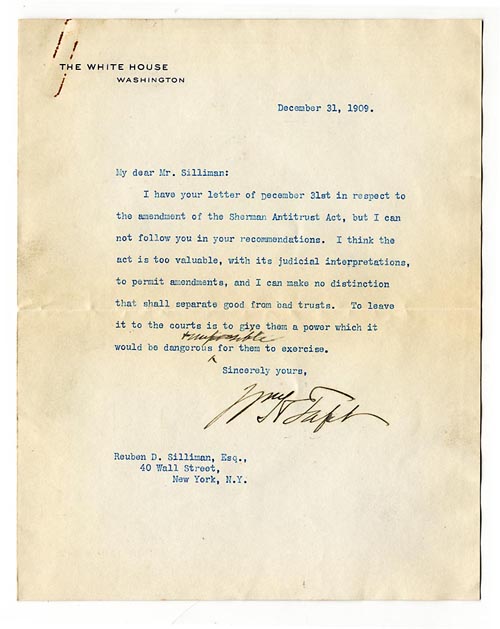Sold – President (and Future Chief Justice) William H. Taft Champions the Sherman Act

"I can make no distinction that shall separate good from bad trusts".
Although Taft was Theodore Roosevelt’s handpicked successor, the reformers that had supported TR became disillusioned with Taft, as his policies increasingly reflected those of conservative party regulars. This led to a disasterous feud between the two presidents, with Taft being remembered in history as a stodgy opponent of reform. Yet the true...
Although Taft was Theodore Roosevelt’s handpicked successor, the reformers that had supported TR became disillusioned with Taft, as his policies increasingly reflected those of conservative party regulars. This led to a disasterous feud between the two presidents, with Taft being remembered in history as a stodgy opponent of reform. Yet the true picture was not so black and white. One of the greatest of reforms was the Sherman Antitrust Act, which authorized the federal government to institute proceedings against trusts in order to dissolve them.
After a slow start, as a result of President Roosevelt’s "trust-busting" campaign, the Sherman Act began to be invoked with some success; in 1904 the Supreme Court upheld the government in its suit for dissolution of the Northern Securities Company. Taft could have tried to gut the legislation. Instead, as the following letter illustrates, he defended and advocated the Sherman Act.
Typed Letter Signed on White House letterhead, Washington, December 31, 1909, to Reuben D. Silliman, a New York attorney who had been a Hawaii Circuit Court judge, and had written the President suggesting that the Sherman Act be changed to make “good trusts” legal. “I have your letter of December 31st in respect to the amendment of the Sherman Antitrust Act, but I can not follow you in your recommendations. I think the act is too valuable, with its judicial interpretations, to permit amendments, and I can make no distinction that shall separate good from bad trusts. To leave it to the courts is to give them a power which it would be dangerous and irresponsible for them to execise.”
The words “and irresponsible “ are added in Taft’s hand, showing the nuance of his legal thought on the issue. In 1911, under Taft, the American Tobacco Co. was declared an illegal monopoly and was broken up into separate companies. That same year, the court ruled that John D. Rockefeller’s Standard Oil should be broken up into 33 companies. In the end, Taft instituted twice as many antitrust proceedings as Roosevelt had, a fact not at all consistent with the anti-reform label many give him. In 1921, Taft became Chief Justice of the U.S. Supreme Court. This letter thus affords us a significant insight into the legal views of the nation’s future chief lawmaker.

Frame, Display, Preserve
Each frame is custom constructed, using only proper museum archival materials. This includes:The finest frames, tailored to match the document you have chosen. These can period style, antiqued, gilded, wood, etc. Fabric mats, including silk and satin, as well as museum mat board with hand painted bevels. Attachment of the document to the matting to ensure its protection. This "hinging" is done according to archival standards. Protective "glass," or Tru Vue Optium Acrylic glazing, which is shatter resistant, 99% UV protective, and anti-reflective. You benefit from our decades of experience in designing and creating beautiful, compelling, and protective framed historical documents.
Learn more about our Framing Services






































































































